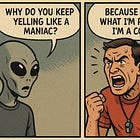IV | No Word from “Coach”
An interstellar adventure about coaching
This is the fourth chapter of No Word from “Coach”. If you have not read it yet, I recommend starting with the first chapter:
5:32: We start the exploration early. Maybe yesterday we did not find the “coaches” we were looking for because we failed to coincide in space and time with them. Today we have adjusted our timing.
5.33: Just stepping out of the spacecraft we disguised as a terrestrial building, we almost crash into a human using bipedal locomotion with cyclical transfers of body weight between lower limbs and combined moments of flight. Although her displacement velocity remains within the usual margins of a Gaussian normal distribution, the subject is dressed in synthetic fabrics designed to reduce air resistance. On one of her upper limbs she carries a device that emits tiny lights and beeping noises —the report said it was called a “little dictator”. The being covers the end of each of her lower limbs with textile and plastic contraptions they call “trainers”. These people are labeled as “runners”.
5.34: We program her displacement speed and start following her, Citcat of Snorom on one side, and I, Duarf of the Euqinhcet, on the other. We ask what she is running away from.
5.35: She answers that she is preparing for an Ironman —a regulated rite of self-destruction. We assume she is fleeing from something important but ask what this preparation consists of. Simply put, she executes the weekly plan sent by a “coach” she has never seen nor met: distances, training exercises, rhythm —all carried out thanks to the “heart rate monitor”, the “little dictator”. We were not aware that to run you needed a “coach”. From what ignorance must he save you, to what expertise must she lead you? If developing a function generally depends on exploiting it in varied ways.
5.36: These humans have spent millennia trying to maximize efficiency —moving as little as possible to achieve as much as possible to survive— and here we find them doing the opposite: forcing themselves, reluctantly, to move, wasting energy, achieving nothing.
5.37: At the end of each of her lower limbs, the “runner” possesses perfectly capable tools for displacement, polished over millennia by natural selection. We ask why she covers them with textile and plastic contraptions called “trainers”.
5.38: Moving at full speed in the opposite direction, we observe another human attached to a mechanical artifact with two wheels, propelled by his own biological energy —called a “cyclist”. Telepathically, in a millisecond, Citcat of Snorom and I agree that it may be interesting to interact with him. We split up. Citcat of Snorom activates wheel displacement and programs the cyclist’s speed.
5.39: As if nothing had happened, in response to my serious question about the “trainers”, the “runner” reacts with “laughter”, which I interpret as treating it like a joke. I do not understand the fun in disabling your own body; in killing a biological catapult that absorbs impacts, stores elastic energy, and releases it to propel the body forward. They are disabling a long elastic Achilles tendon, a plantar arch, an aligned big toe, an impact-resistant calcaneus, sensory receptors in every foot, a general joint capacity to absorb shock… everything that has enabled them to be a species capable of running and walking long distances. The “runner” points out that she had to buy seven different pairs, taking out three loans, before finding ones that did not hurt. I do not know if this is meant as an achievement that elevates her above others, or as a confession exposing her own foolish behavior. This seems to be a recurring pattern in the human species: create a problem where none exists, invent an object that “solves” this “problem”, and end up venerating it as if it were indispensable, as if it were a “coach”.


